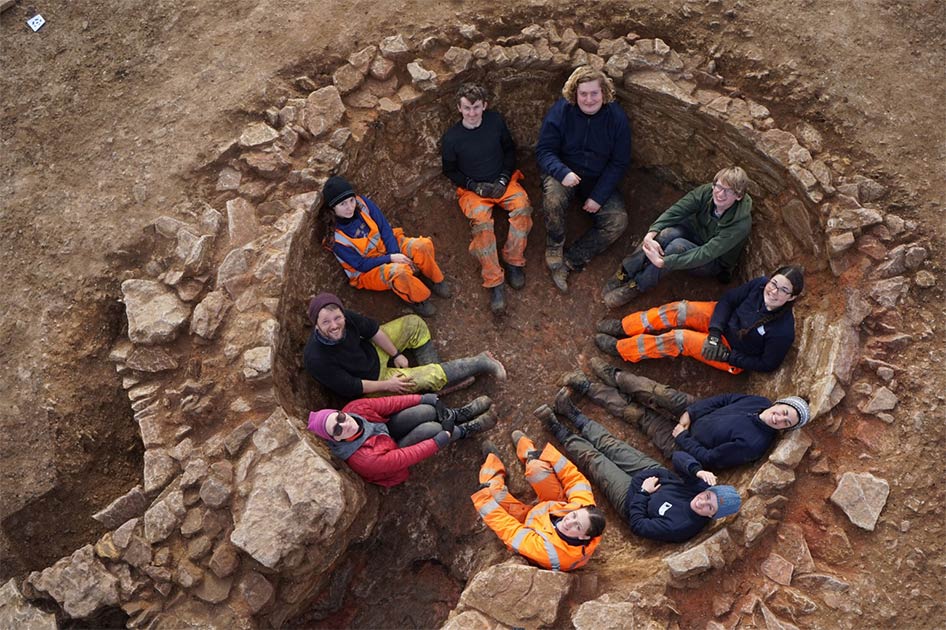The remains of a Roman period industrial complex has been uncovered by archaeologists in England, and includes kilns for making lime, mortar and pottery, and this discovery represents a detailed picture of what life was like for working class folk in the Roman outpost of Britannia.
The Ruined Legacy of Roman Builders in England
In the 1st century BC most of what today is Northamptonshire became a northerly territory of the Catuvellauni, a Belgic tribe who were conquered by the Romans in 43 AD, and over 40 Roman villas are known in Northamptonshire alone. The famous Roman road “Watling Street”, connecting the north of England with London, passed through the county knitting together Roman settlements at Northampton, Kettering and along the Nene Valley near Raunds, with a large fort at Longthorpe.

Dating to the 5th century, when the Roman occupation began to fail causing economic and social unrest across the empire, the Late Romano-British industrial complex was discovered by archaeologists from Oxford Archaeology East at a Roman villa estate at Priors Hall Park housing development in the Borough of Corby, Northamptonshire. After they discovered evidence of large-scale stone and clay quarrying nearby, they found two tile kilns, a large lime kiln for the production of mortar and five pottery kilns.

Sea Gods Were In Fashion At That Time, Apparently
This site was first excavated in the 1950s by archaeologists and the modern team say the organization and finance required to build the villas would have been considerable. The various functional areas of this ancient Roman kiln site were found to have been connected by a large metallic surface on which materials required to construct and operate a large Roman villa about 984 feet (300 meters) to the east would have been moved. And amidst the archaeology a stash of Roman period coins and animal bones along with pottery and metal items, including jewelry, tools and other artifacts, were also discovered at the industrial production site.

An article in the Daily Mail says these discoveries offer “a rare insight into the lives of the estate workers as opposed to the villa owner,” as most other previous discoveries have shown. And one especially rare coin depicts a rebel Roman emperor Allectus , who ruled over a breakaway empire in Britain in 293 AD, which the archaeologists say is valuable “beyond just monetary” because it was pierced with a single hole which suggests it was for wearing as a fashion item, perhaps like an ancient Che Guevara t-shirt.
Roman Industrial Complex is All About ‘Archaeology of the People’
Why the archaeology at Priors Hall is being treated so importantly is because only this site provides such a wealth of evidence of several sets of specially trained tradespeople like builders and carpenters, tile makers and mortar producers. And attempting to put bones around who these trained workers were, the archaeologists think they were most probably hired from nearby towns and villages.

And offering the researchers a dazzling insight as to what the ancient crafts people wore, a rare, complete, zoomorphic copper-alloy buckle was unearthed depicting two dolphins and the sea gods Neptune and Oceanus, which provides hard evidence of the preferred fashion and tastes of the trade people of that time. And further connecting the researchers with the ancient artisans at the site, a quantity of ceramic tiles have been found to be marked with fingerprints from the people who made them, and one specific tile fragment even includes the partial inscription of its makers name.

In conclusion, this single Roman site is extra special in archaeological terms because it tells the story of common English people and not the old story of how Roman elites lived in Britannia. In a Telegraph article Nigel Wakefield, development director at Urban&Civic which owns the archaeological site, said that while it was always known that the site had a rich Roman history, what wasn’t realized until now is “how they were actually constructed,” and these new discovered represent a newfound understanding of the skill sets and materials used in Roman construction.





